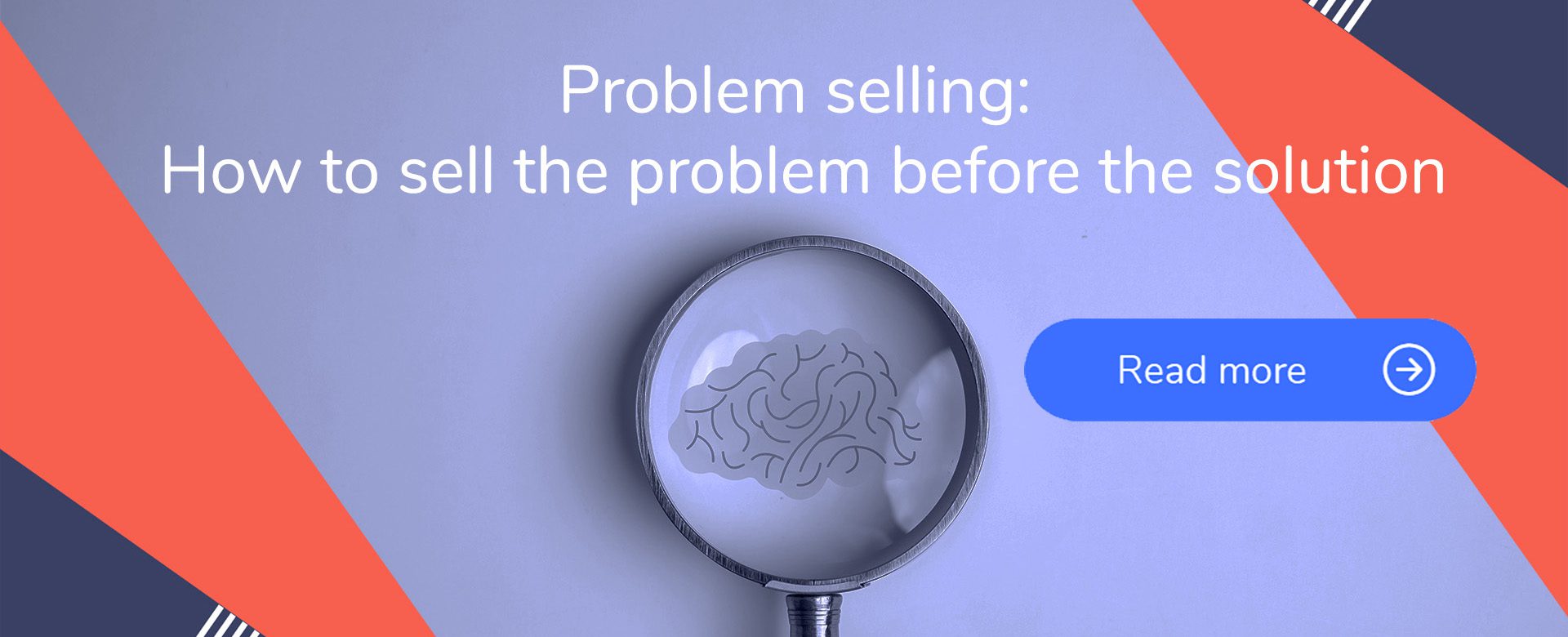Solution selling: what is it, who is it for and how can you start gaining from it?

‘You either have to be part of the solution, or you’re going to be part of the problem.’
Eldridge Cleaver
The premise behind solution selling is so widely accepted that it may appear to be part of the life-blood and genetic make-up of a sales person, rather than a sales methodology that needs appraising and adopting.
Stripped to its bare bones it goes a little something like this:
‘You need to understand what your prospect needs and then tailor your approach the products, services and terms that will best fulfil these’.
Hardly rocket science, is it?
So, why do companies spend tens of thousands training their teams to (better) practice solution selling. And should you be investing too?
Sales methodologies
If you’re arriving late to the class, pull up a chair. We’re looking at solution selling as part of a wider review of sales methodologies.
- Why we use sales methodologies.
- A look at the five most popular of the ‘ologies’.
- And how you can introduce new ways of selling to your team.
Right now, we’re about to dissect solution selling.
- First off, we’ll cleanly separate its definition from surrounding matter.
- Next, we’ll remove its pros and cons one by one.
- And finally, we’ll show you how to adopt solution selling without destroying the beating heart of your team.
If you’re sitting comfortably, let’s begin.
Solution selling – a definition
‘I can say without any hesitation that closing, the so-called skill of asking for the order, is not a big problem. The real problem with closing is not adequately defining or diagnosing the prospect’s problems in the first place.’
Keith Eades, The New Solution Selling: The Revolutionary Sales Process That is Changing the Way People Sell (2003).
As a term, ‘solution selling’ was introduced by Michael Bosworth in the 1970s. Michael was working for Xerox at the time and felt their packages could feel intangible. The solution was his answer to making things more concrete.
His initial work was intended for internal use among the photocopier brand’s sales team but, thanks in large part to Bosworth’s commercial acumen, it quickly became a trademarked phenomenon.
Since then, sales coaching powerhouse SPI, has developed and further refined the concept.
The methodology is based on ‘problem solving’ to ‘finding and present a tailored solution’. It has been refined and developed by others into SPIN, consultative, RAIN and customer-centric selling (to name a few).
All solution-based sales methodologies revolve around two things:
1. Finding ways to make your customers’ lives better (through your offering)
2. And persuading customers that your offering is more suitable than your competitors.
What sets solution selling apart as an approach is that it is not about pushing products, but about creating connections with potential buyers by:
- Developing tailored solutions and unique value propositions.
- Using insights as a sales tool to build confidence, trust and belief.
- Focussing on this value rather than elaborating on features (often by placing a greater emphasis on the service side of the solution).
- Aligning the entire company with the delivery of the solution.
- Providing a customer-centred, end-to-end sales experience but remaining firmly in control of every stage of the negotiation.
Solutions and problems
What sets solution selling apart can also be where it begins to fall apart for organisations not able to deliver on its promise.
Solution selling deliberately moves the pitch from a fetishistic focus on the product to a more wholesome panorama that takes in support throughout the entire sales process.
This is no ‘wham, bang, thank you mam’ sale.
Instead it is all about helping the customer throughout their buying journey and on into all aspects of the customer experience. It is an enhancement and enlargement of the sales process to cover the entire customer journey from consideration to decision to implementation to use.
Solution selling is literally a relationship that encompasses both pre- and post-sale. And, while this makes it attractive, it also relies on the buy-in not just from the sales team but the entire company.
Without that it crumbles and with it goes brand reputation.
Here are a few other solutions and problems it poses:
✔ Solution selling goes hand-in-hand with storytelling – and everyone loves a good story.
Far from being suited to hard sell, it relies on presenting a story that leaves prospects to draw their own conclusions. This sense of buying into a story – rather than being sold a tale – creates strong identification and commitment.
× The focus on both product features and service requires co-ordination and co-operation across the entire vendor/supplier organisation.
Similarly, the promise of perfectly tailored solutions for each buyer creates complications that may lead to mis-alignment between sales and those responsible for aspects of service delivery.
✔ With nearly 50 years under its belt, solution selling has been refined, adapted and built up a solid bank of evidence and best practice to draw on.
× As an understanding of the prospect lies at its heart, there can be the risk that the initial fact-finding mission on which the sales methodology rests, can leave buyers bemused and feeling like the sales process is not moving forward.
✔ If handled correctly, however, the process becomes less a game of cat and mouse and more a partnership or relationship.
× The preferred method of a Q&A format for fact finding can lead to a sterile initial sell. Until the story is ready to be told the methodology relies on a rather rigid fact-finding mission with little reassuring narrative flow.
✔ The methodology favours neither enterprises, SMEs or start-ups. Its emphasis on value proposition over specific features provides plenty of room to leverage the particular strengths of any company. And, while enterprises may be able to offer more, smaller companies will find it easier to remain flexible and to co-ordinate delivery/agreement internally.
× Although refinements have been made to the approach, it remains, broadly speaking, better-suited to services that are hard to describe, intangible, expensive and characterised by a long sales cycle.
‘Solution selling is a process to take the guesswork out of difficult-to-sell, intangible products, and services. No more smoke and mirrors, blind luck, or high-pressure selling. Just a step-by-step system that ensures a higher rate of success for salespeople and a higher probability that the buyer’s expectations will be met.’
Michael Bosworth, Solution Selling: Creating Buyers in Difficult Selling Markets (1994)
How to implement solution selling for your business
1. Know thyself
Your sales team are going to have to know the product/service and after-sales capability of the business inside-out. Without prior in-depth charting it’s impossible to map solutions to pain points.
This will require an ongoing commitment to maintaining a detailed (and 100% correct) knowledge base, accessible to all.
2. Understand their pain points
The more you understand likely pain points prior to engaging a prospect the quicker rapport can be built. Research all the information held on your CRM thoroughly for clues, as well as using information you can pick up from knowledge of similar companies, the industry sector and social media feeds. Matching a buyer to a customer persona is a useful shorthand at this stage.
3. Practice makes perfect
Your sales team will need a bank of questions to draw on – and sample scripts – to help them quickly and accurately identify a prospect’s pain points.
These should take them from the discovery phase’s open-ended questions to the confirmation phase’s more specific, probing queries.
As well as looking for the best way to pursue a sale, your salespeople also need to be carefully qualifying the prospect to avoid a long sales cycle that, in the end, has no wheels.
4. Education, education, education
So far, so good. And, to a certain extent, so familiar. But at this stage solution selling starts to veer more radically from the traditional route and switches from sales patter to storytelling.
The first route in is to find the ‘light bulb’ moment. This is the moment that illuminates exactly why your prospect needs your solution.
It will be a business-critical pain point such as reducing costs, achieving ROI, saving time, driving efficiency, achieving consistency and so on.
Around this climactic glow of the tungsten you will weave an electricity-carrying narrative. So, assuming the tungsten glows brightest for ROI, you can use a set of questions to dramatize the realisation of your company’s worth.
- Would [the solutions our service offers] help you compete from a stronger footing?
- Would this help you close more deals?
- Would it help you achieve a higher LTV on each deal?
- How is not solving [the problem to which I have a solution] currently affecting performance?
- Do you see this getting worse?
- Is it something that needs addressing right now or just a niggling concern you can tackle gradually?
- Can you estimate – or have you forecast – exactly what [this situation] means in terms of revenue?
- Are the measures you have in place addressing this?
- What percentage of your revenue is reliant on new business?
- Will you be able to achieve this going forward without [a solution]?
And the moral of this ‘question story’ is:
‘Both [Namedrop] and [Namedrop] operate in a very similar market to you. I’d like to share how we’ve been working with them recently to address exactly [the situation] you are facing. One of these has partnered with us for a couple of years – and the other we are still helping to find a resolution quickly.
I think you’ll be impressed by the scale and pace that both of their [problem area] has improved and continues to improve. Would you like to know a little more about exactly how we worked with them to achieve this?’
5. Ringing the value bell – loud and clear
Solution selling closes deals not by stacking up features but by ringing the largest bell in the belfry.
It pulls the rope of the biggest pain point there is – and concentrates on letting the value implications of solving this ring out loud.
To do this it must be made clear that, unless the problem is solved, there will be no ‘ding, dong, merrily on high’. A deathly silence will fall.
This is sales as campanology – with each value delivered reverberating harmoniously.
Your sales team will need decks, case studies and visuals that reveal what impact your solution will have (now and in the future) …
… on budget
… on delivery time
… on consistency and quality
… on internal resourcing/outsourcing
… on efficiency
… on stress/retention/wellbeing
… and so on.
6. The end is just the beginning
When you close a solution sale you effectively open up a whole new chapter.
The deal signed has as much to do with after-sales service and creating a partnership as it does collecting signatures in the here and now.
Before that deal is signed, however, is when objections start to come out into the open thick and fast.
This is Boy Scout time for your sales team.
Be prepared – have a list of previously heard objections or anticipated possibilities that detail exactly how each can be handled.
Whatever objections arise, remember, the lynch-pin of this deal is why your prospect needs this service and what this service will deliver. Keep returning to this and objections quickly lose their punching power.
Solution selling: ‘Look to the future, it’s only just begu-hu-un!’
Solution selling is about two things:
- Creating a vision of the future – a brighter, better future.
- Selling a relationship as a solution, rather than selling features.
The trick here is simple in theory but – as the investment in training over its near half-century suggests – it is difficult to master in practice.
It requires painting a picture that becomes real.
And telling a story that is believed.
Your sales team must persuasively tailor a solution and sell the value delivered. They must convince prospects that:
This can happen.
If you only come onboard.





Share